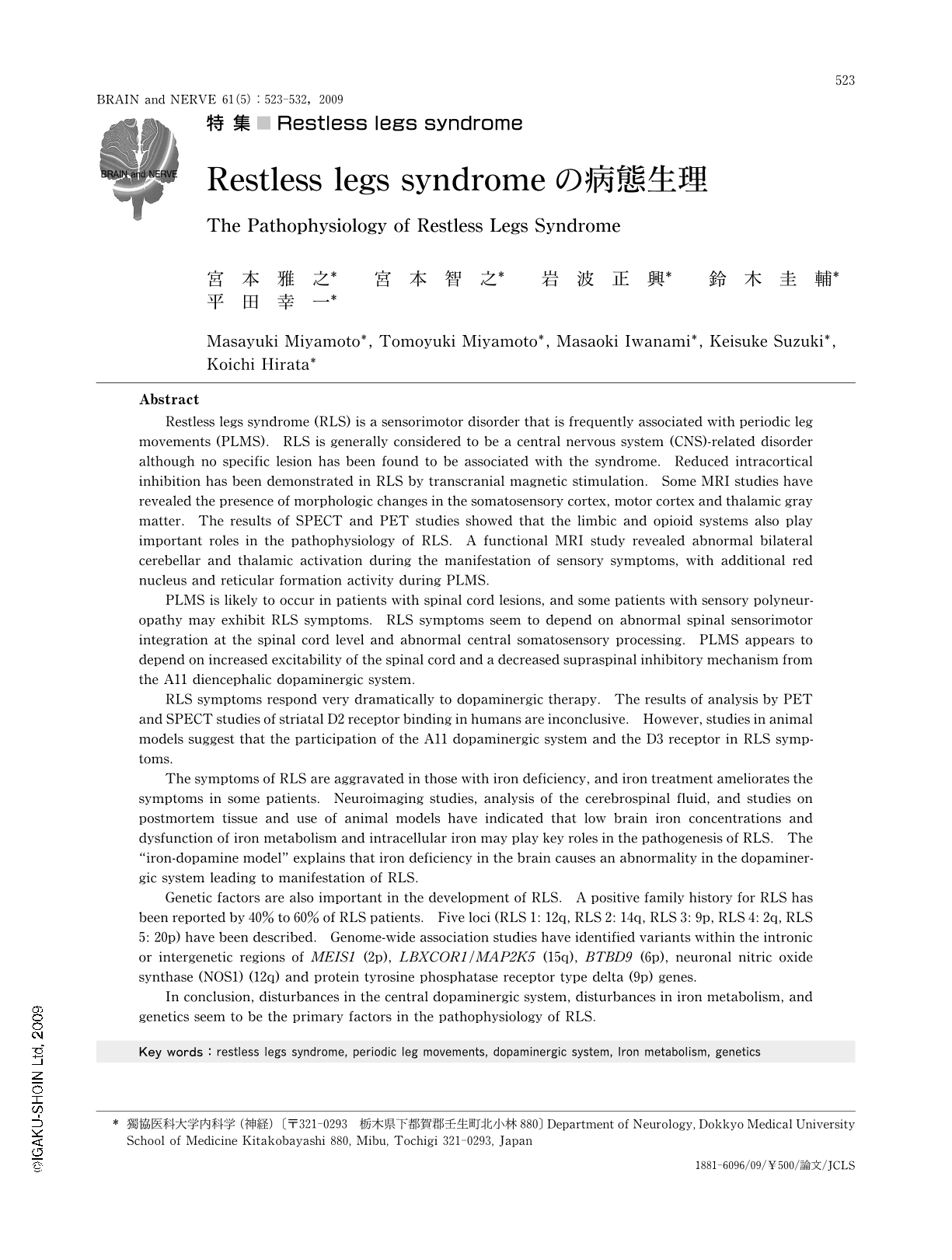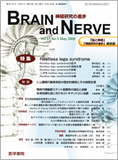Japanese
English
- 有料閲覧
- Abstract 文献概要
- 1ページ目 Look Inside
- 参考文献 Reference
はじめに
Restless legs syndrome(RLS)は,むずむず脚症候群,下肢静止不能症候群とも称し,主に下肢の不快感に伴う異常運動により不眠をもたらす病態である。ここではRLSの病態生理について,神経生理,神経薬理,神経画像診断,神経病理,動物モデルおよび遺伝的要因の観点から最新の知見を含め概説する。
Abstract
Restless legs syndrome (RLS) is a sensorimotor disorder that is frequently associated with periodic leg movements (PLMS). RLS is generally considered to be a central nervous system (CNS)-related disorder although no specific lesion has been found to be associated with the syndrome. Reduced intracortical inhibition has been demonstrated in RLS by transcranial magnetic stimulation. Some MRI studies have revealed the presence of morphologic changes in the somatosensory cortex, motor cortex and thalamic gray matter. The results of SPECT and PET studies showed that the limbic and opioid systems also play important roles in the pathophysiology of RLS. A functional MRI study revealed abnormal bilateral cerebellar and thalamic activation during the manifestation of sensory symptoms, with additional red nucleus and reticular formation activity during PLMS.
PLMS is likely to occur in patients with spinal cord lesions, and some patients with sensory polyneuropathy may exhibit RLS symptoms. RLS symptoms seem to depend on abnormal spinal sensorimotor integration at the spinal cord level and abnormal central somatosensory processing. PLMS appears to depend on increased excitability of the spinal cord and a decreased supraspinal inhibitory mechanism from the A11 diencephalic dopaminergic system.
RLS symptoms respond very dramatically to dopaminergic therapy. The results of analysis by PET and SPECT studies of striatal D2 receptor binding in humans are inconclusive. However, studies in animal models suggest that the participation of the A11 dopaminergic system and the D3 receptor in RLS symptoms.
The symptoms of RLS are aggravated in those with iron deficiency, and iron treatment ameliorates the symptoms in some patients. Neuroimaging studies, analysis of the cerebrospinal fluid, and studies on postmortem tissue and use of animal models have indicated that low brain iron concentrations and dysfunction of iron metabolism and intracellular iron may play key roles in the pathogenesis of RLS. The "iron-dopamine model" explains that iron deficiency in the brain causes an abnormality in the dopaminergic system leading to manifestation of RLS.
Genetic factors are also important in the development of RLS. A positive family history for RLS has been reported by 40% to 60% of RLS patients. Five loci (RLS 1: 12q, RLS 2: 14q, RLS 3: 9p, RLS 4: 2q, RLS 5: 20p) have been described. Genome-wide association studies have identified variants within the intronic or intergenetic regions of MEIS1 (2p), LBXCOR1/MAP2K5 (15q), BTBD9 (6p), neuronal nitric oxide synthase (NOS1) (12q) and protein tyrosine phosphatase receptor type delta (9p) genes.
In conclusion,disturbances in the central dopaminergic system,disturbances in iron metabolism,and genetics seem to be the primary factors in the pathophysiology of RLS.

Copyright © 2009, Igaku-Shoin Ltd. All rights reserved.


